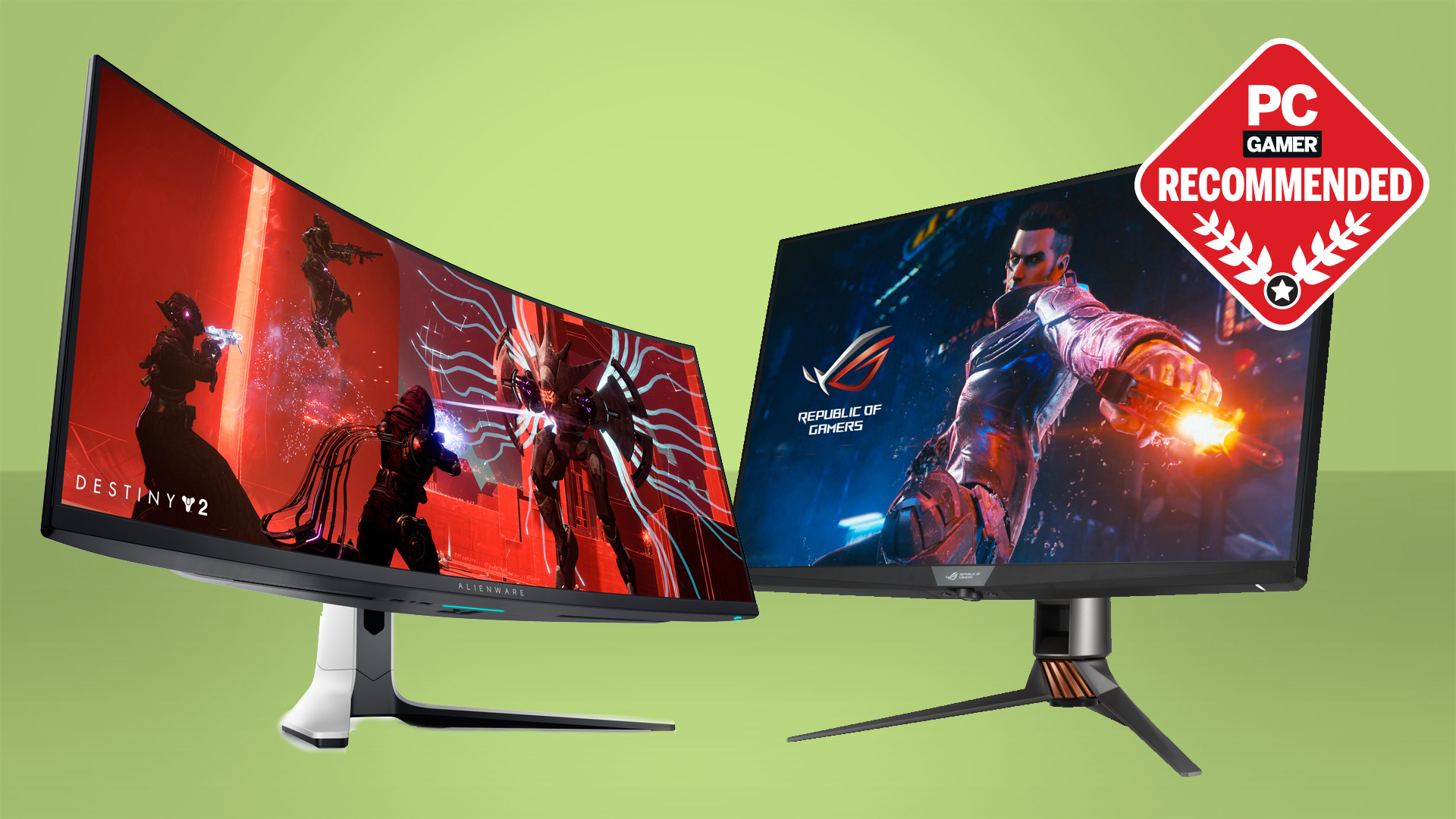
The best G-Sync monitors will let you get the most out of your Nvidia GeForce graphics card.
The best G-Sync monitors make gaming a silky smooth experience. Link your Nvidia graphics card up to your G-Sync capable monitor and the result is an experience that will ruin playing on a non-G-Sync setup. Since 2013, this Nvidia tech has eradicated screen tearing and stuttering from games.
But what is G-Sync tech? For the uninitiated, G-Sync is Nvidia’s name for its frame synchronization technology. It makes use of dedicated silicon in the monitor so it can match your GPU’s output to your gaming monitor’s refresh rate, for the smoothest gaming experience. It removes a whole load of guesswork in getting the display settings right, especially if you have an older GPU. The catch is that the tech only works with Nvidia GPUs.
G-Sync Ready or G-Sync Compatible monitors can be found, too. They’re often cheaper, but the monitors themselves don’t have dedicated G-Sync silicon inside them. You can still use G-Sync, but for best results, you want a screen that’s certified by Nvidia.
Here’s where things might get a little complicated: G-Sync features do work with AMD’s adaptive FreeSync tech monitors, but not the other way around. If you have an AMD graphics card, you’ll for sure want to check out the best FreeSync monitors along with checking our overall best gaming monitors for any budget.
Best G-Sync monitors
(Image credit: Future)
(Image credit: Future)
(Image credit: Future)
(Image credit: Future)
(Image credit: Asus)
Brand new gaming monitor technology comes at a premium, and the Asus ROG Swift PH32UQX proves that point. As the world’s first Mini-LED gaming monitor, it sets a precedent for both performance and price, delivering extremely impressive specs for an extreme price tag.
The PG32UQX is easily one of the best panels I’ve used to date. The colors are punchy yet accurate and that insane brightness earns the PG32UQX the auspicious DisplayHDR 1400 certification. However, since these are LED zones and not self-lit pixels like an OLED, you won’t get those insane blacks for infinite contrast.
Mini-LED monitors do offer full-array local dimming (FALD) for precise backlight control, though. What that means for the picture we see is extreme contrast from impressive blacks to extremely bright DisplayHDR 1400 spec.
If you want to brag with the best G-Sync gaming monitor around, this is the way to do it.
Beyond brightness, you can also expect color range to boast about. The colors burst with life and the dark hides ominous foes for you to slay in your quest for the newest loot.
Of course, at 4K you’ll need the equivalent of one of the best gaming PCs to get 144fps. I did get Doom Eternal to cross the 144Hz barrier in 4K HDR using an RTX 3080 and boy was it marvelous.
That rapid 144Hz refresh rate is accompanied by HDMI 2.0 and DisplayPort 1.4 ports, along with two USB 3.1 ports join the action, with a further USB 2.0 sitting on the top of the monitor to connect your webcam.
And of course, we expected no less than excellent 4K resolution, especially at this price.
As for its G-Sync credentials, the ROG Swift delivers G-Sync Ultimate, which is everything a dedicated G-Sync chip can offer in terms of silky smooth performance and support for HDR. So if you want to brag with the best G-Sync gaming monitor around, this is the way to do it. However, scroll on for some more realistic recommendations in terms of price.
Read our full Asus ROG Swift PG32UQX review.
(Image credit: Future)
(Image credit: Future)
(Image credit: Future)
(Image credit: Future)
(Image credit: Future)
(Image credit: Alienware, Dell)
(Image credit: Alienware, Dell)
OLED has truly arrived on PC, and in ultrawide format no less. Alienware’s 34 QD-OLED is one of very few gaming monitors to receive such a stellar score from us, and it’s no surprise. Dell has nailed the OLED panel in this screen and it’s absolutely gorgeous for PC gaming. Although this monitor isn’t perfect, it is dramatically better than any LCD-based monitor by several gaming-critical metrics. And it’s a genuine thrill to use.
What that 34-inch, 21:9 panel can deliver in either of its HDR modes—HDR 400 True Black or HDR Peak 1000—is nothing short of exceptional. The 3440 x 1440 native resolution image it produces across that gentle 1800R curve is punchy and vibrant. With 99.3% coverage of the demanding DCI-P3 colour space, and fully 1,000 nits brightness, it makes a good go, though that brightness level can only be achieved on a small portion of the panel.
Still, there’s so much depth, saturation and clarity to the in-game image thanks to that per-pixel lighting, but this OLED screen needs to be in HDR mode to do its thing. And that applies to SDR content, too. HDR Peak 1000 mode enables that maximum 1,000 nit performance in small areas of the panel but actually looks less vibrant and punchy most of the time.
The Alienware 34 QD-OLED’s response time is absurdly quick at 0.1ms.
HDR 400 True Black mode generally gives the best results, after you jump into the Windows Display Settings menu and crank the SDR brightness up, it looks much more zingy.
Burn-in is the great fear and that leads to a few quirks. For starters, you’ll occasionally notice the entire image shifting by a pixel or two. The panel is actually overprovisioned with pixels by about 20 in both axes, providing plenty of leeway. It’s a little like the overprovisioning of memory cells in an SSD and it allows Alienware to prevent static elements from “burning” into the display over time.
Latency is also traditionally a weak point for OLED, and while we didn’t sense any subjective issue with this 175Hz monitor, there’s little doubt that if your gaming fun and success hinges on having the lowest possible latency, there are faster screens available. You can only achieve the full 175Hz with the single DisplayPort input, too.
The Alienware 34 QD-OLED’s response time is absurdly quick at 0.1ms, and it cruised through our monitor testing suite. You really notice that speed in-game, too.
There’s no HDMI 2.1 on this panel, however. So it’s probably not the best fit for console gaming as a result. But this is PC Gamer, and if you’re going to hook your PC up to a high-end gaming monitor, we recommend it be this one.
Read our full Alienware 34 QD-OLED (AW3423DW) review.
(Image credit: LG )
(Image credit: LG)
(Image credit: LG)
(Image credit: LG)
(Image credit: LG)
4K gaming is a premium endeavor. You need a colossal amount of rendering power to hit decent frame rates at such a high resolution. But if you’re rocking a top-shelf graphics card, like an RTX 3080, RTX 3090, or RX 6800 XT then this dream can be a reality, at last. While the LG 27GN950-B is a fantastic gaming panel, it’s also infuriatingly flawed.
The LG UltraGear is the first 4K, Nano IPS, gaming monitor with 1ms response times, that’ll properly show off your superpowered GPU. Coming in with Nvidia G-Sync and AMD’s FreeSync adaptive refresh compatibility, this slick slim-bezel design even offers LG’s Sphere Lighting 2.0 RGB visual theatrics.
And combined with the crazy-sharp detail that comes with the 4K pixel grid, that buttery smooth 144Hz is pretty special.
The color fidelity of the NanoIPS panel is outstanding.
While it does suffer with a little characteristic IPS glow. It appears mostly at the screen extremities when you’re spying darker game scenes, but isn’t an issue most of the time. The HDR is a little disappointing as, frankly, 16 edge-lit local dimming zones do not a true HDR panel make.
What is most impressive, however, is the Nano IPS tech that offers a wider color gamut and stellar viewing angles. And the color fidelity of the NanoIPS panel is outstanding.
The LG UltraGear 27GN950-B bags you a terrific panel with exquisite IPS image quality. Despite the lesser HDR capabilities, it also nets beautiful colors and contrast for your games too. G-Sync offers stable pictures and smoothness, and the speedy refresh rate and response times back this up too.
And while the lack of HDMI 2.1 and USB Type-C is a little limiting, especially looking forward, right now it’s one of the best monitors going.
Read our full LG Ultragear 27GN950 review.
(Image credit: Future)
(Image credit: MSI)
(Image credit: MSI)
The MSI Optix MPG321UR is kitted out for high-speed 4K gaming, and it absolutely delivers. Despite the price point this monitor doesn’t have a physical G-Sync chip, it is officially certified and has been tested by Nvidia to hit the necessary standards for G-Sync compatibility. It does also offer FreeSync Premium Pro certification, as well as DCI-P3 RGB color space and sRGB.
That makes this a versatile piece of kit, and that 3840 x 2160 resolution is enough to prevent any pixelation across this generous, 32-inch screen. The 16:9 panel doesn’t curve, but does offer a professional-level, sub 1ms grey-to-grey (GTG) response rate.
Sadly, there’s been no effort to build in any custom variable overdrive features, so you’ll have to expect you’ll get artifacts on fast moving objects.
Still, the MSI Optix MPG321UR does come with a 600nit peak brightness, and Vesa HDR 600 certification, alongside 97% DCI-P3 colour reproduction capabilities. All this goes toward an amazingly vibrant screen that’s almost accurate enough to be used for professional colour grading purposes.
Plus, it’s HDMI 2.1 inputs will let you run current console games at their peak 4K 120Hz output settings.
The Optix is one of MSI’s more recent flagship models, so you know you’re getting serious quality and performance. Its panel looks gorgeous, even at high speeds, managing a 1ms GTG response time.
Though MSI’s Optix is missing a physical G-Sync chip, it’ll still run nicely with any modern Nvidia GPU, or AMD card if you happen to have one of those lying around.
Read our full MSI OPTIX MPG321UR review.
(Image credit: Future)
(Image credit: Future)
(Image credit: Future)
(Image credit: Future)
(Image credit: Future)
The Xeneon is Corsair’s attempt at breaking into the gaming monitor market. To do that, the company has opted for 32 inches of IPS panel at 1440p resolution. Once again we’re looking at a FreeSync Premium monitor that has been certified to work with GeForce cards by Nvidia.
It pretty much nails the sweetspot for real-world gaming, what with 4K generating such immense levels of GPU load and ultrawide monitors coming with their own set of limitations.
The 2,560 by 1,440 pixel native resolution combined with the 32-inch 16:9 aspect panel proportions translate into sub-100DPI pixel density. That’s not necessarily a major problem in-game. But it does make for chunky pixels in a broader computing context.
It‘s punchy, vibrant, and well-calibrated.
Here, you’re looking at a swanky cast aluminum stand, which adjusts for height, tilt, and swivel, and is a definite cut above the norm for build quality. The OSD menu UI is clearer and more logical than many, too, and those unusually high levels of polish and refinement extend yet further.
That sub-3ms response, combined with a 165Hz refresh, means the thing isn’t a slouch when it comes to gaming capability, though there are certainly more impressive gaming monitors out there.
The two HDMI 2.0 sockets are limited to 144Hz, and the DisplayPort 1.4 interface is predictable enough. But the USB Type-C with power delivery for a single cable connection with charging to a laptop is a nice extra. Or, at least, it would be if the charging power wasn’t limited to a mere 15W, which is barely enough for something like a MacBook Air, let alone a gaming laptop.
The core image quality is certainly good, though. It‘s punchy, vibrant, and well-calibrated. And while it’s quite pricey for a 1440p model, it delivers all it sets out to with aplomb. On the whole, the Corsair Xeneon 32QHD165 doesn’t truly excel at anything, but it’s still a worthy consideration in 2022.
Read our full Corsair Xeneon 32QHD165 review.
(Image credit: Acer)
(Image credit: Acer)
Housing Nvidia’s tech alongside a 4K resolution and HDR tech means that this is an absolute beast of a monitor that will give you the best of, well, everything. And by everything, we mean everything.
The XB273K’s gaming pedigree is obvious the second you unbox it: it is a 27-inch, G-Sync compatible, IPS screen, that boasts a 4ms gray-to-gray response rate, and a 144Hz refresh rate. While that may not sound like a heck of a lot compared to some of today’s monitors, it also means you can bag it for a little less.
And for a 4K resolution panel with HDR, it’s not a bad buy.
Assassin’s Creed Odyssey looked glorious. This monitor gave up an incredibly vivid showing, and has the crispest of image qualities to boot; no blurred or smudged edges to see and each feature looks almost perfectly defined and graphically identified.
The contrasts are particularly strong with any colors punching through the greys and blacks.
Particular highlights are the way water effects, lighting, reflections and sheens are presented, but there is equal enjoyment to be had from landscape features, the people, and urban elements. All further benefiting from a widespread excellence in color, contrast, shades (and shadows), and tones.
The contrasts are particularly strong with any colors punching through the greys and blacks. However, the smaller details here are equally good, down to clothing detail, skin tone and complexion, and facial expressions once again. There is an immersion-heightening quality to the blacks and grays of the Metro and those games certainly don’t feel five years old on the XB273K.
The IPS panel is also made better by Acer’s integrated VisionCare technology that will aim to protect your retinas—plus, it looks damn good.
The buttons to access the menu are easy enough to use, and the main stick makes it particularly simple to navigate. And the ports you have available increase your ability to either plug and go or adapt to your machines’ needs: an HDMI; DisplayPort and five USB 3.0 ports are at your service.
The Predator XB273K is one for those who want everything now and want to future-proof themselves in the years ahead. It might not have the same HDR heights that its predecessor, the X27, had, but it offers everything else for a much-reduced price tag. Therefore, the value it provides is incredible, even if it is still a rather sizeable investment.
Read our full Acer Predator XB273K review.
(Image credit: Future)
(Image credit: Future)
(Image credit: Future)
(Image credit: Future)
(Image credit: Future)
Best gaming monitor: pixel-perfect panels for your PC
Best high refresh rate monitor: screaming quick screens
Best 4K monitor for gaming: when only high-res will do
Best 4K TV for gaming: big-screen 4K PC gaming
The best just got a whole lot better. That’s surely a foregone conclusion for the new Samsung Odyssey Neo G9. After all, the original Odyssey G9 was already Samsung’s tip-top gaming monitor. Now it’s been given the one upgrade it really needed. Yup, the Neo G9 is packing a mini-LED backlight.
Out of the box, it looks identical to the old G9. Deep inside, however, the original G9’s single most obvious shortcoming has been addressed. And then some. The Neo G9 still has a fantastic VA panel. But its new backlight doesn’t just have full-array rather than edge-lit dimming.
It packs a cutting-edge mini-LED tech with no fewer than 2,048 zones. This thing is several orders of magnitude more sophisticated than before. As if that wasn’t enough, the Neo G9’s peak brightness has doubled to a retina-wrecking 2,000 nits. What a beast.
The problem with any backlight-based rather than per-pixel local dimming technology is that compromises have to be made. Put another way, an algorithm has to decide how bright any given zone should be based on the image data. The results are never going to be perfect.
Visible halos around small, bright objects are the sort of issue you expect from full-array dimming. But the Neo G9 has its own, surprisingly crude, backlight-induced image quality issues. Admittedly, they’re most visible on the Windows desktop rather than in-game or watching video.
Graphics-heavy titles such as Cyberpunk 2077 or Witcher III are what the G9 does best.
If you position a bright white window next to an all-black window, the adjacent edge of the former visibly dims. Or let’s say you move a small, bright object over a dark background. The same thing happens. The small, bright object dims. Even uglier, if something like a bright dialogue box pops up across the divide between light and dark elements, the result is a gradient of brightness across the box.
All this applies to both SDR and HDR modes and, on the Windows desktop, it’s all rather messy and distracting. Sure, this monitor isn’t designed for serious content creation or office work. But at this price point, it’s surely a serious flaw.
Still, that 1000R curve, huge 49-inch proportions, and relatively high resolution combine to deliver an experience that few, if any, screens can match. Graphics-heavy titles such as Cyberpunk 2077 or Witcher III are what the G9 does best. In that context, the Samsung Odyssey Neo G9 delivers arguably the best visual experience on the PC today.
In practice, the Neo G9’s mini-LED creates as many problems as it solves. We also can’t help but observe that, at this price point, you have so many options. The most obvious alternative, perhaps, is a large-format 120Hz OLED TV with HDMI 2.1 connectivity.
Read our full Samsung Odyssey Neo G9 review.
Best gaming monitors | Best 4K monitors for gaming | Best graphics cards
Best gaming PC | Gaming PC build | Best gaming chair
G-Sync gaming monitor FAQ
What is the difference in G-Sync and G-Sync Compatible?
G-Sync and G-Sync Ultimate monitors come with a bespoke G-Sync processor, which enables a full variable refresh rate range and variable overdrive. G-Sync Compatible monitors don’t come with this chip, and that means they may have a more restricted variable refresh rate range.
Fundamentally, though, all G-Sync capable monitors offer a smoother gaming experience than those without any frame-syncing tech.
Should I go for a FreeSync or G-Sync monitor?
In general, FreeSync monitors will be cheaper. It used to be the case that they would only work in combination with an AMD GPU. The same went for G-Sync monitors and Nvidia GPUs. Nowadays, though, it is possible to find G-Sync compatible FreeSync monitors if you’re intent on spending less.
Should I go for an IPS, TN or VA panel?
We would always recommend an IPS panel over TN. The clarity of image, viewing angle, and color reproduction are far superior to the cheaper technology, but you’ll often find a faster TN for cheaper. The other alternative, less expensive than IPS and better than TN, is VA tech. The colors aren’t quite so hot, but the contrast performance is impressive.
Jargon buster – gaming monitor terminology
Refresh Rate (Hz)
The speed at which the screen refreshes. For example, 144Hz means the display refreshes 144 times a second. The higher the number, the smoother the screen will appear when you play games.
V-Sync
Graphics tech synchronizes a game’s framerate with your monitor’s refresh rate to help prevent screen tearing by syncing your GPU frame rate to the display’s maximum refresh rate. Turn V-Sync on in your games for a smoother experience, but you’ll lose information, so turn it off for fast-paced shooters (and live with the tearing). Useful if you have an older model display that can’t keep up with a new GPU.
G-Sync
Nvidia’s frame synching tech that works with Nvidia GPUs. It basically allows the monitor to sync up with the GPU. It does by showing a new frame as soon as the GPU has one ready.
FreeSync
AMD’s take on frame synching uses a similar technique as G-Sync, with the biggest difference being that it uses DisplayPort’s Adaptive-Sync technology which doesn’t cost monitor manufacturers anything.
Ghosting
When movement on your display leaves behind a trail of pixels when watching a movie or playing a game, this is often a result of a monitor having slow response times.
Response Time
The amount of time it takes a pixel to transition to a new color and back. Often referenced as G2G or Grey-to-Grey. Slow response times can lead to ghosting. A suitable range for a gaming monitor is between 1-4 milliseconds.
TN Panels
Twisted-nematic is the most common (and cheapest) gaming panel. TN panels tend to have poorer viewing angles and color reproduction but have higher refresh rates and response times.
IPS
In-plane switching, panels offer the best contrast and color despite having weaker blacks. IPS panels tend to be more expensive and have higher response times.
VA
Vertical Alignment panels provide good viewing angles and have better contrast than even IPS but are still slower than TN panels. They are often a compromise between a TN and IPS panel.
HDR
High Dynamic Range. HDR provides a wider color range than normal SDR panels and offers increased brightness. The result is more vivid colors, deeper blacks, and a brighter picture.
Peak Brightness
This refers to the maximum brightness of a monitor or television and is measured in nits.
Ultrawide
Shorthand for monitors with aspect wider aspect ratios like 32:9 or 21:9
Resolution
The number of pixels that make up a monitor’s display, measured by height and width. For example: 1920 x 1080 (aka 1080p), 2560 x 1440 (2K), and 3840 x 2160 (4K).





